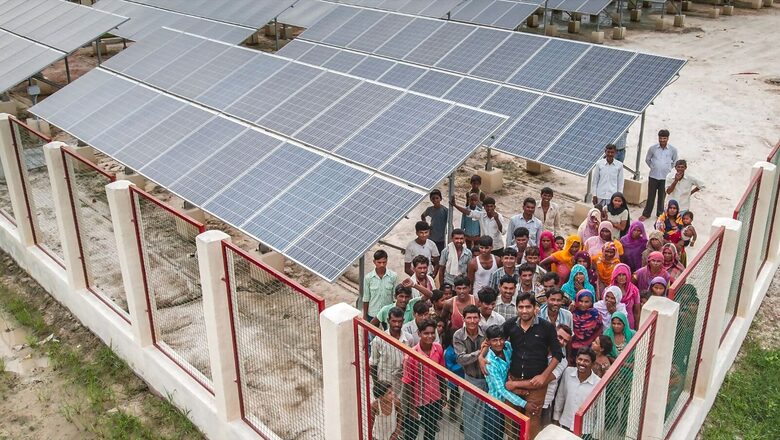
views
As the race to Net Zero gathers pace, India on Wednesday announced that it has set aside priority capital investment of Rs 35,000 crore towards energy transition as well as energy security.
Net Zero is a point when all the greenhouse emissions released by human-led activities are counterbalanced by removal of almost equal amount of emissions from the atmosphere. India has committed to reaching the target by 2070, with short-term goals of increasing renewables capacity to 500GW by 2030, and meeting 50 per cent of energy requirements from renewables.
Reiterating the government’s commitment to climate action, Finance Minister Nirmala Sitharaman listed ‘Green Growth’ as one of the seven big priorities along with infrastructure and investment, financial sector, inclusive development as well as youth power, as she presented the annual budget in Parliament on Wednesday.
“We are implementing many programmes for green fuel, green energy, green farming, green mobility, green buildings, and green equipment, and policies for efficient use of energy across various economic sectors. These green growth efforts help in reducing carbon intensity of the economy and provides for large- scale green job opportunities,” she said.
Mega Impetus to Clean Energy, Grid Connectivity for Ladakh
The government has also allocated Rs 20,700 crore, including central support of Rs 8,300 crore, for building the inter-state transmission system for evacuation and grid integration of 13GW renewable energy from Ladakh.
The transmission lines will bring clean energy round-the-clock to residents of the far-flung villages, including the defence establishments in the Himalayan region, which largely remain cut-off during winters. The project was in the pipeline for long but faced hurdles until it was formally approved in 2021.
While the Ladakh renewable energy plan is important for India to reach its 500GW RE target in this decade, its deployment needs to be done responsibly, say experts. “Ladakh is a fragile ecosystem, which provides ecosystem benefits such as riverine water resources. The mix of technology will define the need and methodology for assessing environmental and social impacts as well as assessing climate risks for the infrastructure itself,” said Namrata Ginoya, Senior Manager, Energy and Resilience, WRI India.
Earlier in January, the government had also given its nod to the National Hydrogen Mission with an outlay of Rs 19,700 crore. Talking about the mission, Sitharaman said the government plans to reach an annual production of 5 MMT by 2030 while facilitating the economy’s transition to low carbon intensity. At the same time, it seeks to reduce dependence on fossil fuel imports.
Sitharaman said a detailed framework for Pumped Storage Projects will also be formulated. Battery Energy Storage Systems with capacity of 4,000 MWH will be supported with Viability Gap Funding in order to steer the economy on the sustainable development path, she added.
The budget has consolidated the government’s position on energy and climate as India heads into G20 presidency, said Balasubramanian Viswanathan from International Institute for Sustainable Development (IISD). “The government clearly identifies green growth as one of the pillars of development, announcing support measures for storage and renewable energy evacuation infrastructure. This is a welcome move as India tries to rapidly increase the share of renewables in the grid,” he added.
Green Credit, Sustainable Cities, Replacing Old Vehicles
Among other things, the Budget also included the government’s plans to notify a Green Credit Programme under the Environment (Protection) Act to incentivise environmentally sustainable and responsive actions by companies, individuals and local bodies. “We are yet to see the details for how some of this will pan out, particularly the green credit programme, but we are headed in a positive direction,” said Madhav Pai, Interim CEO, WRI India & Program Executive Director – Sustainable Cities & Transport.
Replacing old polluting vehicles would be an important part of greening our economy, said the finance minister. “In furtherance of the vehicle scrapping policy mentioned in Budget 2021-22, I have allocated adequate funds to scrap old vehicles of the central government. States will also be supported in replacing old vehicles and ambulances,” said Sitharaman.
Apart from this, states and cities will be encouraged to undertake urban planning reforms and actions to transform our cities into ‘sustainable cities of tomorrow’, said the minister while delivering the Budget. This would mean efficient use of land resources, adequate resources for urban infrastructure, transit-oriented development, enhanced availability and affordability of urban land, and opportunities for all.
Read all the Latest Business News and Budget Live Updates here


















Comments
0 comment